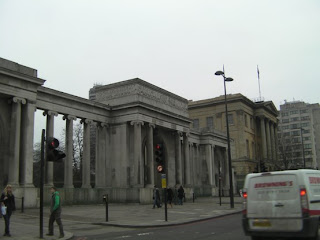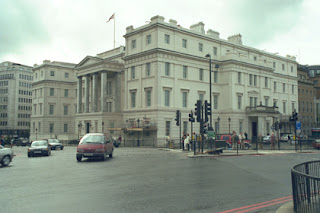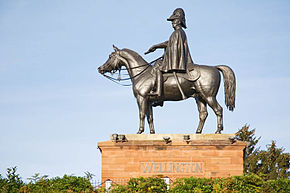From Walks in London by Augustus Hare (1894)
Both in town and country.’
 |
| Hyde Park Gate with Apsley House to the right |
Close to Hyde Park Corner rises the pillared front of Apsley House (Duke of Wellington), over which, on fine afternoons, the sun long threw a spirit-like shadow from the statue of the great Duke upon the opposite gateway. The house was built in 1784 for Henry Bathurst, Lord Apsley, from designs by the brothers Adam: it was originally red brick; the stone front and portico were added in 1828. It will always excite interest from its associations as the residence of Arthur Wellesley, first Duke of Wellington, who died Sept. 14, 1852. At its gates, for many years, people used to watch for the appearance of the silver-haired veteran in his well-known blue coat and white waistcoat and trousers.
On the right of the Entrance Hall in Apsley House is a room appropriated as a kind of Museum of Relics of the Great Duke. It is surrounded by glass cases containing an enormous plateau, candelabra, etc., given by the Spanish and Portuguese Courts after the Peninsular War; a magnificent shield with reliefs symbolising the victories of the Duke, presented, with candelabra, by the Merchants and Bankers of London in 1822; and services of china given by the Russian, Prussian, and French Courts. In a number of table-cases are preserved the swords, batons, and orders (including the extinct order of the Saint Esprit) which belonged to the Duke; his two fieldglasses; the cloak which he wore at Waterloo; the sword of Napoleon I.; the dress worn by Tippoo Saib at his capture; and the magnificent George set with emeralds, originally given by Queen Anne to the Duke of Marlborough, and presented by George IV.
The road which passes beneath the arch leads into the Green Park (of fifty-six acres), called on some old maps Stonebridge Close, on others Upper St. James’s Park. It skirts the gardens of Buckingham Palace by Constitution Hill, where no less than three attempts have been made upon the life of Queen Victoria: the first by a lunatic named Oxford, June 10, 1840; the second by Francis, another lunatic, May 30,1842; and thethird by an idiot named Hamilton, May 19, 1849. It was at the top of the hill that Sir Robert Peel was thrown from his horse, June 29, 1850, and received the injuries from which he died on the 2nd of July. The principal houses on the opposite side of the Park are Stafford House, Bridgewater House, and Spencer House. Till 1825 ‘the Ranger’s Lodge’ stood in the Park near Piccadilly: the stags which ornamented its gateway are now at Albert Gate.


